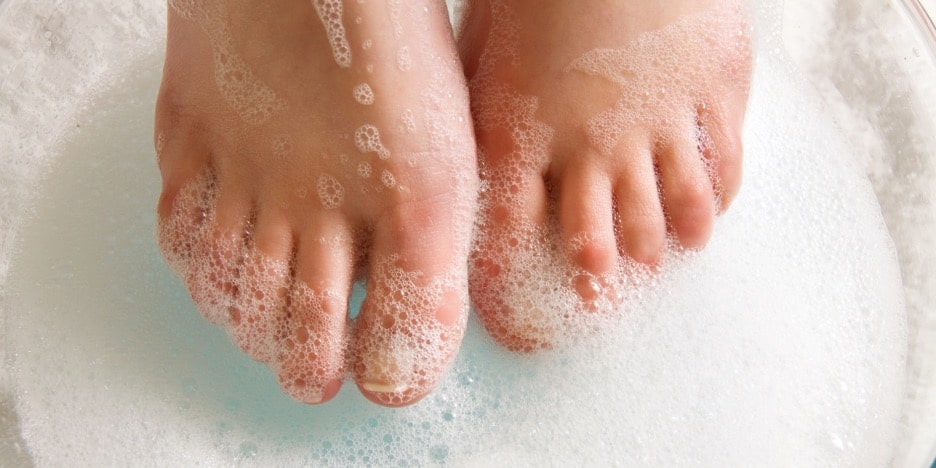How to Deal with Fungal Toenails During a Pandemic
If you or someone you live with has one or more fungal toenails, we don’t need to tell you how frustrating they are to deal with. Although they usually don’t hurt, and usually aren’t dangerous, we won’t blame you if you find yourself a little uncomfortable with the sight of them. Who wants to look down and see thick, discolored, deformed toenails staring back?
When it comes to this unsightly problem, we typically recommend you seek our help as soon as you can. Fungal toenails don’t get better on their own, and the longer you have them, the worse they tend to get. They can even spread to your skin (causing athlete’s foot), then back to infect other nails!
That said, the COVID-19 pandemic makes this entire situation a little trickier than usual. Is now really the right time to seek help for your fungal toenails?

To Treat or Not to Treat
There are a few situations where you should always call us about a fungal toenail infection. The big ones are these:
- You have diabetes, or any other condition that makes you more susceptible to infections. Although it’s relatively rare, those with compromised nerve function, circulation, or immune function are more likely to develop more dangerous complications from untreated fungal toenails.
- Your toenails are causing you pain, restricting your activities, or adversely impacting your quality of life. This might be the case if, say, a misshapen or warped nail is starting to dig uncomfortably into the surrounding skin. Pain is always an urgent problem that should be dealt with swiftly, no matter the cause.
If you are a healthy individual and your fungal toenails aren’t bothering you, then you have more of a judgment call to make.
We’ve already given you some reasons why we think treating fungal toenails really shouldn’t wait if you can help it. The longer you wait, the worse it will get, the greater the chance it will spread, and the greater the likelihood of difficulties with treatment.
We have also implemented extensive procedures to keep our office as safe, healthy, and sterile as possible, and fungal toenail treatment tends to be fairly “hands off.” More on that later in the post. So you shouldn’t feel guilty if you decide this is something you want to deal with sooner rather than later.
That being said, you might also decide you’d rather wait. If so, it’s really important that you keep a close eye on your toenails and employ some key home care strategies in the meantime.
Containing the Spread of Fungal Nails at Home
The unfortunate reality is that home treatments for fungal toenails tend to have a very high failure rate. Topical medications usually can’t get underneath the nail to attack the fungal infection where it lives.
In order to have any real chance, you typically need to thin your nails on a weekly basis and apply a topical medication to the nail and the surrounding skin at least once per day. Even then, it may take more than a year to see full results—if it works at all.
However, even if home care isn’t going to reverse your situation, you may still be able to slow the spread of the infection and keep it from reaching other toes—or other people in your household!
Here are a few key tips:
- Wash your feet with mild soap and water every day, then make sure you pat them dry thoroughly afterward.
- Don’t keep your feet in socks and shoes that have become sweaty and damp. Change them as often as you need to. (A pair of sandals with good arch support is a good choice for proper ventilation, if you don’t mind the fungal nail being visible.)
- Rotate closed-toed shoes so that each pair gets a minimum of 24 hours’ drying time after you wear them for a day. Apply an antifungal powder or spray to the shoes, too, to make them an even more hostile environment for fungi.
- Treat any existing fungal skin infections (especially athlete’s foot) immediately. These are caused by the exact same types of fungi that also cause fungal toenails, and they can easily spread back from the skin to the nails to infect more of them.
- Don’t share nail clippers or foot care supplies with anyone else in your household. Don’t use the same clippers for your toenails and fingernails, and disinfect tools thoroughly after using them. Wash your hands thoroughly after any contact with your fungal toenails.
One more: as we said, keep a close eye on your fungal toenails. Examine them every day. You can even take a picture with your cell phone every week or so to compare progress.
As we said, the worse your fungal toenails get, the more difficult it will be to treat them properly and the longer it will be before you start to see results. So if your toenails are getting worse—or you notice more are starting to get infected—it may be time to throw in the towel and give us a call.

Advanced, Effective Care from Waco Foot & Ankle
If you do decide to come in for professional care, we will do everything we can to help you restore clear, healthy nails as quickly and safely as possible.
We offer a variety of treatment options, including both prescription strength oral antifungal medications and laser therapy.
These techniques (including topical medications as well) are not mutually exclusive. In some cases, we may recommend a combination of therapies to give you the best chance at achieving optimal results.
And regardless of the treatments you choose, you can rest assured that we will make your overall health and safety our top priority. We are strictly following state and CDC guidelines and have put extra safety precautions and procedures into practice. And fungal toenail treatments themselves won’t require you to spend a lot of time in our office or in close contact with others.
As for the results of treatment, we won’t lie—it will take time. Even with laser therapy, the most advanced option, it may take several months for the damaged part of the nail to grow out and full results to be realized.
However, fungal toenails will never go away on their own, and the earlier you seek treatment, the faster and better the results tend to be.
To request an appointment with our team, or to ask us any questions you may wish about our treatments, policies, or procedures, please call us anytime at (254) 776-6995, or fill out our online contact / appointment request form.
.
